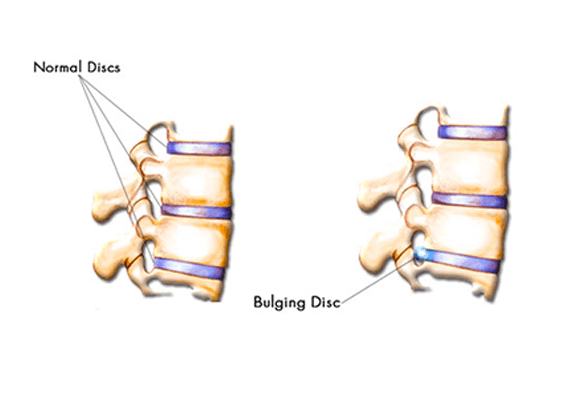Bulging Disc Symptoms
A bulging disc may occur anywhere throughout the thoracic, cervical or lumbar region of the spine. Unfortunately, symptoms of a bulging disc may not be present until the bulging disc causes spinal compression.
When a nerve root is compressed by a bulged disc, the symptoms will correspond with the location of the compressed or pinched nerve.
Symptoms in the Cervical Spine
When a bulging disc occurs in the cervical region, these symptoms are possible:
- Arm muscle weakness
- Deep pain near or over the shoulder blades on the affected side
- Increased pain when bending the neck or turning head to the side
- Neck pain, especially in the back and sides
- Pain made worse with coughing, straining or laughing
- Pain radiating to the shoulder, upper arm, forearm, and rarely the hand, fingers or chest
- Spasm of the neck muscles
Symptoms in the Lumbar Spine
A bulging disc in the lumbar spine may be revealed through the following symptoms:
- Muscle spasm
- Muscle weakness or atrophy in later stages
- Pain made worse with coughing, straining or laughing
- Pain radiating to the buttocks, legs, and feet
- Severe low-back pain
- Tingling or numbness in legs or feet
A bulging disc in the lumbar area can also cause debilitating sciatica with pain, limiting your mobility – decreasing the quality of your life.
Symptoms in the Thoracic Spine
A bulging disc in the thoracic spine may cause the following symptoms:
- Muscle weakness, numbness or tingling in one or both legs
- Increased reflexes in one or both legs that can cause spasticity pain in the upper back or radicular pain to the chest and stomach area.
- Muscle spasm and changes in posture in response to the injury. Loss of motion, inability to bend and stand erect or poor tolerance to sitting
- Sitting and bending can be difficult if the bulge is severe. Often the patient will present in a shifted posture and have difficulty finding a comfortable position.
- If the disc bulges into the spinal cord area it can result in sensory loss and weakness below the affected level along with balance and possible bowel and bladder issues.
Surgery for Bulging Disc Symptoms
If an MRI or other imaging test reveals a bulging disc, conservative treatment could help reduce the symptoms. Chiropractic treatment, physical therapy and lifestyle changes may help provide some reprieve from the pain. Unfortunately, those suffering from a pinched nerve or compressed nerves may not find relief through conservative remedies.
Surgical intervention may be needed so the pinched or compressed nerves may have room to heal.
Some surgical treatment options for a bulging disc include:
The Bonati Spine Institute encourages patients with bulging discs to contact us to request a no-obligation MRI review or discuss your conditions with our medical professionals. Find out why The Bonati Spine Procedures are considered to be among the world’s best solutions when it comes to advanced spine surgery. Your pain from a bulging disc can become a thing of the past.
Check out one of our patient’s stories of recovery from a bulging disc by clicking here.

